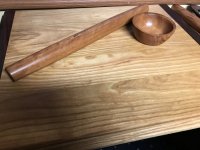Alan R McDaniel Jr
Member
- Messages
- 269
- Location
- Victoria, TX
So, I made the pastry boards for #1 wife and my 3 DILs. Visiting one of them today I noticed the pastry board out within easy reach, which is good showing it was being used. Upon a perfunctory inspection I noticed that the Walnut end piece was sticking out past the edge of the ash board. Now I looked closer. The ash had shrunk more than 1/8" from both ends and on both sides. Oddly the glue joint did not appear to be broken or separated. That ash has been stickered under cover for over 30 years. Granted it was not in a climate controlled storage, but I did not expect what I saw. When I got home I checked #1 wife's board. Same thing. One other DIL has responded that her's is shrinking also. While I anticipated some movement, I did not expect it to move that much.
I figure I'll wait six months or so and trim and re-glue if required.
Alan
I figure I'll wait six months or so and trim and re-glue if required.
Alan


